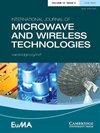大型射电望远镜天线基于学习的表面变形恢复
IF 1.3
4区 计算机科学
Q3 ENGINEERING, ELECTRICAL & ELECTRONIC
International Journal of Microwave and Wireless Technologies
Pub Date : 2024-02-16
DOI:10.1017/s1759078724000217
引用次数: 0
摘要
大型射电望远镜主反射镜的表面形变与其工作效率密切相关,这对一些天文科学研究非常重要。在此,我们提出了一种基于深度学习的表面形变恢复框架,以非干涉强度测量值作为输入。我们开发了递归卷积神经网络(RCNN)来建立主反射镜表面形变与孔径平面和近场平面上的强度图像之间的反映射关系。同时,采用物理前向传播模型,以高效的计算方式生成大量数据进行预训练。然后,利用实验数据通过迁移学习对反映射关系进行调整和改进,从而使所需的训练图像集数量减少了 15 倍,这有利于促进深度学习在该领域的实际应用。此外,RCNN 模型可作为去噪器进行训练,对测量点的轴向定位误差具有鲁棒性。将这种方法推广到自适应光学研究中也是大有可为的。本文章由计算机程序翻译,如有差异,请以英文原文为准。
Learning-based surface deformation recovery for large radio telescope antennas
The surface deformation of the main reflector in a large radio telescope is closely related to its working efficiency, which is important for some astronomical science studies. Here, we present a deep learning-based surface deformation recovery framework using non-interferometric intensity measurements as input. The recurrent convolutional neural network (RCNN) is developed to establish the inverse mapping relationship between the surface deformation of the main reflector and the intensity images at the aperture plane and at a near-field plane. Meanwhile, a physical forward propagation model is adopted to generate a large amount of data for pre-training in a computationally efficient manner. Then, the inverse mapping relationship is adjusted and improved by transfer learning using experimental data, which achieves a 15-fold reduction in the number of training image sets required, which is helpful to facilitate the practical application of deep learning in this field. In addition, the RCNN model can be trained as a denoiser, and it is robust to the axial positioning error of the measuring points. It is also promising to extend this method to the study of adaptive optics.
求助全文
通过发布文献求助,成功后即可免费获取论文全文。
去求助
来源期刊

International Journal of Microwave and Wireless Technologies
ENGINEERING, ELECTRICAL & ELECTRONIC-TELECOMMUNICATIONS
CiteScore
3.50
自引率
7.10%
发文量
130
审稿时长
6-12 weeks
期刊介绍:
The prime objective of the International Journal of Microwave and Wireless Technologies is to enhance the communication between microwave engineers throughout the world. It is therefore interdisciplinary and application oriented, providing a platform for the microwave industry. Coverage includes: applied electromagnetic field theory (antennas, transmission lines and waveguides), components (passive structures and semiconductor device technologies), analogue and mixed-signal circuits, systems, optical-microwave interactions, electromagnetic compatibility, industrial applications, biological effects and medical applications.
 求助内容:
求助内容: 应助结果提醒方式:
应助结果提醒方式:


